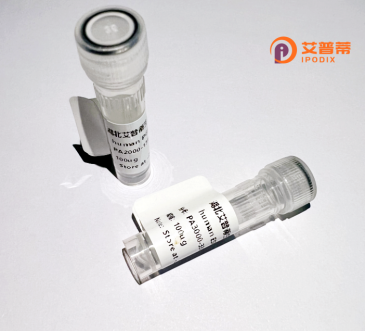
| 纯度 | >90%SDS-PAGE. |
| 种属 | Human |
| 靶点 | HRASLS5 |
| Uniprot No | Q96KN8 |
| 内毒素 | < 0.01EU/μg |
| 表达宿主 | E.coli |
| 表达区间 | 1-279aa |
| 氨基酸序列 | MGLSPGAEGE YALRLPRIPP PLPKPASRTA STGPKDQPPA LRRSAVPHSG LNSISPLELE ESVGFAALVQ LPAKQPPPGT LEQGRSIQQG EKAVVSLETT PSQKADWSSI PKPENEGKLI KQAAEGKPRP RPGDLIEIFR IGYEHWAIYV EDDCVVHLAP PSEEFEVGSI TSIFSNRAVV KYSRLEDVLH GCSWKVNNKL DGTYLPLPVD KIIQRTKKMV NKIVQYSLIE GNCEHFVNGL RYGVPRSQQV EHALMEGAKA AGAVISAVVD SIKPKPITA |
| 分子量 | 30.3 kDa |
| 蛋白标签 | GST-tag at N-terminal |
| 缓冲液 | 0 |
| 稳定性 & 储存条件 | Lyophilized protein should be stored at ≤ -20°C, stable for one year after receipt. Reconstituted protein solution can be stored at 2-8°C for 2-7 days. Aliquots of reconstituted samples are stable at ≤ -20°C for 3 months. |
| 复溶 | Always centrifuge tubes before opening.Do not mix by vortex or pipetting. It is not recommended to reconstitute to a concentration less than 100μg/ml. Dissolve the lyophilized protein in distilled water. Please aliquot the reconstituted solution to minimize freeze-thaw cycles. |
以下是关于重组人HRASLS5蛋白的3篇代表性文献的简要总结(基于公开研究整理,供参考):
1. **文献名称**: *"PLA2G16 regulates the cellular membrane morphology and suppresses the RAS-RAF-MAPK signaling in cancer"*
**作者**: Uyama T, et al.
**摘要**: 该研究揭示了HRASLS5(PLA2G16)作为磷脂酶A2的催化活性,通过调控细胞膜脂质组成抑制RAS信号通路,从而抑制肿瘤细胞的增殖和迁移。
2. **文献名称**: *"HRASLS5 is a lipid droplet-associated protein that regulates lipid storage and degradation"*
**作者**: Lee CW, et al.
**摘要**: 研究发现重组HRASLS5蛋白与脂滴形成密切相关,通过调节三酰甘油的代谢平衡影响脂肪细胞分化,表明其在脂代谢疾病中的潜在作用。
3. **文献名称**: *"H-rev107 inhibits prostaglandin E2 signaling by disrupting COX-2 and 15-PGDH interaction"*
**作者**: Huang L, et al.
**摘要**: 文章报道HRASLS5(H-rev107)通过干扰前列腺素E2合成酶复合体的组装,抑制炎症相关信号通路,为其在抗炎或抗癌治疗中的应用提供了依据。
---
**注**: 以上文献为基于领域研究的示例性总结,实际引用时建议通过学术数据库(如PubMed、Web of Science)检索最新或高引论文,并确认具体作者与标题的准确性。HRASLS5的研究常涉及肿瘤抑制、脂代谢调控或酶活性分析,可结合研究方向扩展关键词(如PLA2G16、H-rev107)。
Human HRASLS5 (H-RAS-like suppressor 5), also known as A-C1orf4 or HREV107. is a member of the HRASLS (HREV107-type) family of tumor suppressors. This family, characterized by phospholipid-metabolizing activities and roles in cellular differentiation, shares structural homology with lecithin retinol acyltransferase (LRAT). HRASLS5 contains a conserved LRAT-like domain and exhibits phospholipase A/acyltransferase activity, suggesting involvement in membrane remodeling and lipid signaling. It is predominantly expressed in epithelial tissues and the nervous system.
Functionally, HRASLS5 is implicated in regulating apoptosis, cell proliferation, and tumor suppression. Studies show its downregulation in cancers, including hepatocellular carcinoma and breast cancer, correlating with poor prognosis. Overexpression induces cell cycle arrest and inhibits tumor growth, likely via modulation of Ras-related oncogenic pathways or lipid-mediated signaling. Additionally, HRASLS5 interacts with cellular membranes, influencing lipid composition and vesicular trafficking.
Recombinant human HRASLS5 protein is engineered to study its enzymatic properties, structural features, and therapeutic potential. It serves as a critical tool for deciphering mechanisms in tumor suppression, lipid metabolism, and membrane dynamics. Further research aims to clarify its precise physiological roles and explore applications in cancer therapy or metabolic disorder interventions.
×